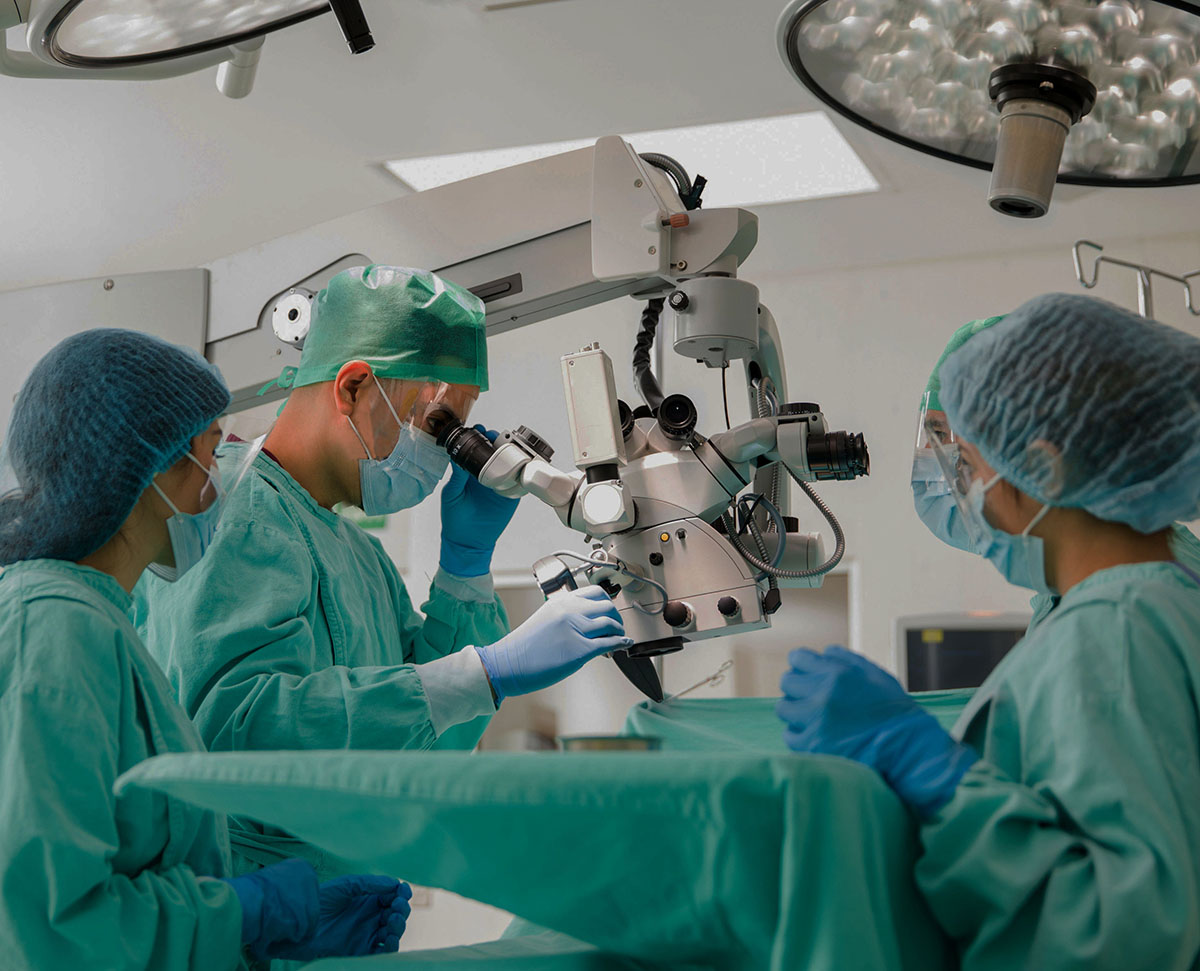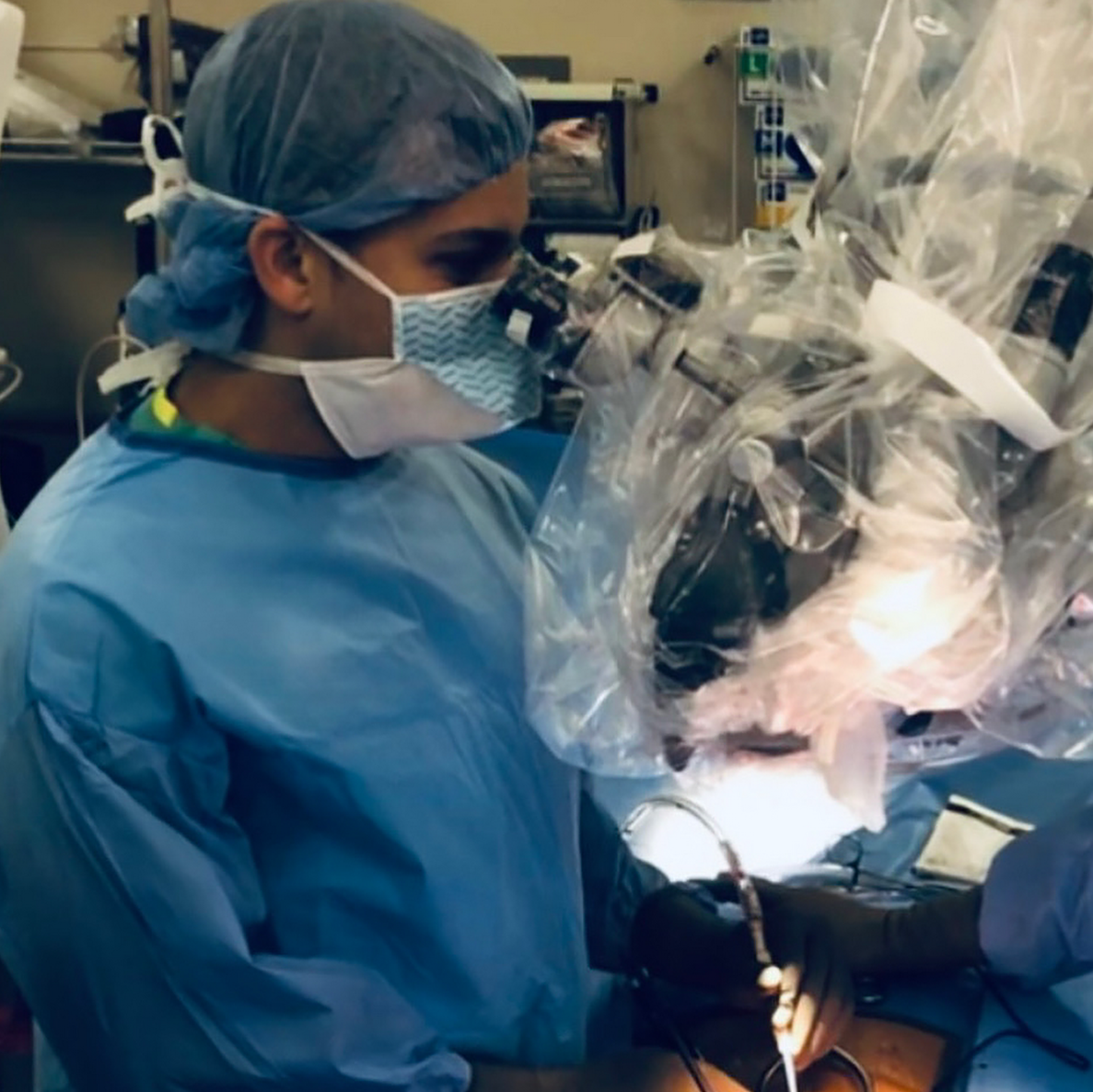
Cervical Spine

Dr. Radcliff is considered one of New Jersey’s most proficient specialists in cervical spine surgery, having performed approximately 2,500 neck surgeries and 150 artificial disc replacement surgeries.
Dr. Radcliff performs five specialized procedures:
-
- Cervical Artificial Disc Replacement
- Cervical Lamino-Foraminotomy
- Cervical Laminoplasty
- Anterior Cervical Discectomy & Fusion (ACDF)
- Posterior Cervical Laminectomy & Fusion
All three of these surgeries are minimally invasive and non-fusion, designed to retain the natural movement of the neck and allow the patient to return to normal activity faster.
Additionally, Dr. Radcliff is one of very few spine surgeons in New Jersey who are trained to perform cervical lamino-foraminotomy and cervical laminoplasty.
“Both of these surgeries are motion-preserving, non-fusion neck surgeries,” explains Dr. Radcliff. “These surgeries require specialized expertise in neck surgery because they involve a posterior approach (from the back of the neck), the use of tiny instruments and microsurgery.”
Cervical Artificial Disc Replacement
Unlike other surgeons who typically are trained in one artificial disc implant, Dr. Radcliff is trained in the use of virtually all the FDA-approved artificial discs for the neck. This enables Dr. Radcliff to select the best artificial disc for each patient’s diagnosis and disc herniation.
The goal of cervical disc replacement is to relieve the pressure on your spinal cord or nerves that are causing the pain, numbness, and weakness that can radiate to your shoulder, arm, and hand. Dr. Radcliff typically performs this surgery for patients who have cervical disc herniation or cervical degenerative disc disease that is causing chronic neck and/or arm pain that hasn’t been relieved from non-surgical treatments.
Through this type of surgery, you:
- Maintain normal motion in the neck
- Have no complications or issues sometimes associated with a bone graft or fusion
- Have a reduced chance of degenerative disc disease in adjacent cervical joints
With cervical artificial disc replacement surgery, Dr. Radcliff removes the injured disc and replaces it with an artificial disc that is designed to replicate natural motion.
Procedure
After making a small incision on the neck, Dr. Radcliff will remove the injured disc. smooth away any bone spurs and then place the artificial disc in the empty space that is left. He then closes the incision and covers it with a dressing.
Recovery
You will then be moved to a recovery room where you will be monitored for the next few hours. After you have recovered, you will be sent home with post-op instructions. Dr. Radcliff may also recommend you wear a soft collar for a short period of time to add support to your neck.
VIDEO: Cervical Artificial Disc Replacement

Cervical Lamino-Foraminotomy
Unlike many neck surgeries that involve fusion, where two vertebrae are locked together, the cervical lamino-foraminotomy procedure avoids fusing the neck vertebrae, which retains the natural movement in the neck.
While “motion preservation” is the goal of most surgeries, most spine surgeons are not able to perform this type of procedure because of the experience needed.
“This type of neck surgery requires the use of a microscope and the use of small 1mm and 2mm instruments to repair the damaged disc rather than removing all of the disc and replacing it with a fusion and metal instrumentation,” Dr. Radcliff explains.
A cervical lamino-foraminotomy is a minimally invasive surgery designed to relieve pressure on the nerve roots in the neck that is causing pain not resolved by conservative therapies such as physical therapy and medication.
Dr. Radcliff most commonly performs cervical lamino-foraminotomy to treat cervical radiculopathy, a condition where nerves in the neck are compressed due to disc herniation, causing radiating neck pain that spreads into the shoulders, arms, and hands.
Procedure
Dr. Radcliff procedure is performed with the patient under general anesthesia and face down on the operating table. After making a small incision on the side of the neck, Dr. Radcliff shaves the spine’s lamina, which is a thin plate of bone that protects the spinal cord, in order to free the offending nerve. He then removes bone spurs and/or disc fragments on the foramen, which is the small opening on both sides of the vertebra, before closing the incision.
Recovery
Most patients are encouraged to begin walking in the hospital within a few hours of surgery once they have recovered from the anesthesia. It is normal for continued pain immediately after surgery, particularly around the incision, and as the inflammation around the offending nerve root slowly decreases. Outpatient physical therapy may be prescribed to help with pain and inflammation and to regain function and control of the neck muscles. Recovery times vary for every patient, but on average, patients recover within two to four weeks.
Cervical Laminoplasty
Like the cervical lamino-foraminotomy, this surgery is also performed through the back of the neck and is intended to retain the natural movement of the neck after surgery. The surgery involves great proficiency and the use of a microscope.
The difference between a laminectomy and a laminoplasty is that more of the lamina is left in place in a laminoplasty procedure. Also, in a laminoplasty, the trained neck surgeon leaves more of the normal bone and ligaments intact, which provides a protective layer that lessens scar tissue formation on the dural sac after surgery.
This type of surgical procedure reshapes or repositions bone to relieve stress on the spinal nerves in the neck. Lamina is the roof of bone over the back of the spinal cord and plastos means “to mold.”
Procedure
Within a laminoplasty surgery, a small portion of the bony part of the spinal canal (lamina) is removed to enlarge the spinal canal, thereby relieving symptoms of nerve root compression. By enlarging the spinal canal, it can relieve symptoms of radiating pain, weakness, or numbness in the arm or hand.
Recovery
Most patients are encouraged to begin walking in the hospital within a few hours of surgery once they have recovered from the anesthesia. It is normal for continued pain immediately after surgery, particularly around the incision, and as the inflammation around the offending nerve root slowly decreases. Outpatient physical therapy may be prescribed to help with pain and inflammation, and to regain function and control of the neck muscles. Recovery times vary for every patient, but on average, patients recover within two to four weeks.
VIDEO: Cervical Laminoplasty
VIDEO: Anterior Cervical Discectomy & Fusion (ACDF)
Anterior Cervical Discectomy & Fusion
Anterior Cervical Discectomy & Fusion, or ACDF, is a Surgery that Dr. Radcliff performs to reduce or eliminate chronic pain in the neck or arm caused by a disc problem. ACDF can be used to treat herniated discs, arthritis, bone spurs, and stenosis in the cervical spine.
During the procedure, he will remove a piece of damaged disc tissue in the neck area to relieve pressure on the spinal cord or nerve roots. In some cases, by removing a piece of the shock-absorbing disc that separates the two vertebrae, the structures may become less stable. Consequently, when the disc is removed, Dr. Radcliff may recommend “fusing” the vertebrae to prevent instability.
Dr. Radcliff may use bone from the patient’s hip or from a bone bank to stabilize two vertebrae after a discectomy. During a fusion surgery, the disc is removed, and the surgeon inserts a small wedge of bone in between the two vertebrae to restore the disc space. Over time, the two vertebrae “fuse” together into a solid structure. While this limits movement and flexibility, it can also help to ease pain.
The decision to fuse or not to fuse can be a complex one. Dr. Radcliff will base the decision on the assessment of two factors: the amount of instability that a discectomy will cause and how much disc space is necessary to restore.
Dr. Radcliff has performed over 5,000 of these procedures. He has trained other surgeons on cervical spine surgery including ACDF at several premier labs in the world.
Procedure
Dr. Radcliff performs the surgery under special magnification to reduce the invasiveness. Special instruments are used to reach the spine.
Typically, patients are considered good surgical candidates if they:
- Show signs of disc disease on imaging scans
- Have pain, weakness, or tingling in one or both hands or arms
- Have tried other nonsurgical approaches but have not improved
Each disc is called a “level.” A one-disc ACDF can be done as an outpatient procedure, meaning you will go home the same day of your surgery. A two-disc or greater ACDF may require an overnight hospital stay. You will be placed under general anesthesia during the procedure. You may experience some mild pain post-operatively; however, it should be easily managed with medication.
Recovery
Recovery may take several weeks, and you may be required to wear a hard collar to aid with neck stabilization. You should avoid strenuous activity for 6 weeks after your surgery. You’ll likely be able to drive 1-2 weeks after your procedure.
After surgery, you may be recommended to a physical therapist to reduce pain and restore mobility. Exercise has been shown to aid recovery; however, you should obtain permission from your surgeon before starting or resuming an exercise regimen.
Posterior Cervical Laminectomy & Fusion
During this procedure, Dr. Radcliff will remove a piece of damaged disc tissue in the neck area to relieve pressure on the spinal cord or nerve roots. In some cases, by removing a piece of the shock-absorbing disc that separates the two vertebrae, the structures may become less stable. Consequently, when the disc is removed, Dr. Radcliff may recommend “fusing” the vertebrae to prevent instability.
A cervical laminectomy is performed to make more room in the spinal cord and nerves, relieving pressure, irritation, and inflammation around the nerves due to bone spurs. This surgery is generally performed if you have three or more herniated discs. Laminectomy may also be used in cases of spinal stenosis in which the entire canal is narrowed like a ring on a swollen finger.
Dr. Radcliff may recommend a cervical laminectomy and fusion if:
- Nonsurgical treatments have been ineffective
- You have muscle weakness or numbness
- You have decreased bowel or bladder control
Procedure
Dr. Radcliff will make an incision on the back of your neck. Laminectomy involves the removal of part or all of the bone covering the spinal canal. The purpose of this procedure can be to free nerve roots, remove a tumor, bone spur, or to perform certain types of fusion procedures.
Removing the lamina (laminectomy) is much like removing the cover on a fuse box to access the wiring. By removing the lamina, Dr. Radcliff gains access to the disc area and frees more space for the nerves inside.
Dr. Radcliff will then remove any fragments that may have broken away from the disc, as well as the area of the disc that is herniated and pressuring a nerve root.
After the laminectomy is performed, Dr. Radcliff will place screws to fuse the affected vertebrae to give the spine strength and stability. Dr. Radcliff may use bone from the patient’s hip or from a bone bank to stabilize two vertebrae after a discectomy. During a fusion surgery, Dr. Radcliff inserts pieces of bone in between the two vertebrae to restore the disc space. Over time, the two vertebrae “fuse” together into a solid structure. While this limits movement and flexibility, it can also help to ease pain.
The decision to fuse or not to fuse can be a complex one. It will probably be based on Dr. Radcliff’s assessment of two factors: the amount of instability that a discectomy will cause and how much disc space is necessary to restore.
Recovery
Typically, you’ll be up and moving a few hours post-surgery. You may be required to wear a collar to limit movement in your neck. You’ll likely be able to return home a few days after your procedure.
You may be required to see a physical therapist to improve mobility, regain strength, and increase flexibility.
VIDEO: Laminectomy, Cervical Spine (with Fusion)


